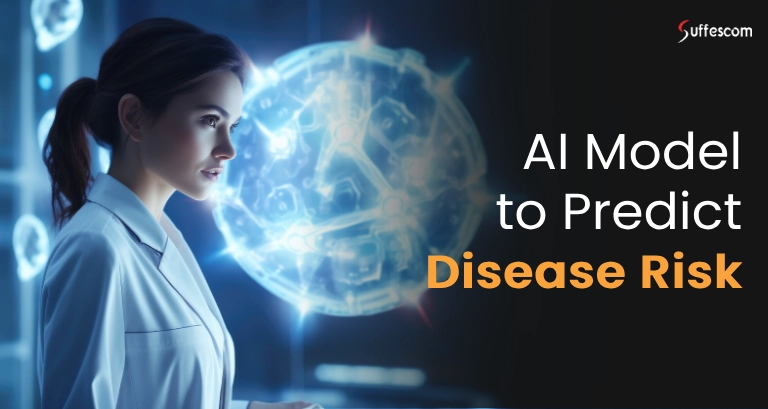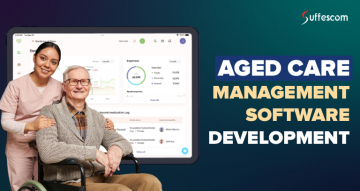AI-Powered Disease Risk Prediction Model Development for Smarter Healthcare

Missed diagnoses and late disease detection cost billions every year and, more importantly, cost lives. Healthcare providers face frustrated patients, overwhelmed staff, and rising costs. AI health risk prediction software development changes that reality. By analyzing vast amounts of patient data, AI identifies risks earlier, supports clinical prediction, and empowers doctors with precise decision-making tools.
With the right system, hospitals can reduce errors, personalize treatments, and deliver care before diseases progress. Our expertise in AI disease risk prediction model development ensures healthcare organizations build reliable, scalable, and high-performing solutions tailored to their needs.
Building an AI model for disease risk prediction that is integrated smoothly into healthcare systems offers one of the clearest paths to reducing both the economic and human costs of medical inefficiency.
In this guide, we’ll break down how these models work, the diseases they can detect, the algorithms behind them, and the exact steps to build one.
Why AI Disease Risk Prediction Is Essential?
Traditional risk prediction often fails because patient data is scattered across reports, imaging, wearables, and genetic information. Around 20–40% of global healthcare spending is wasted due to inefficiencies most linked to late or missed diagnoses.
Develop AI Models for Disease Risk Prediction in Healthcare to bridge this gap. AI connects disparate data points medical history, lab results, real-time wearable data and uncovers patterns invisible to the human eye. This supports predictive modelling, healthcare analytics, and faster clinical prediction.
The global predictive disease analytics market, valued at $4.24 billion in 2024, is expected to reach $20.4 billion by 2034. Healthcare providers, insurers, and governments now view AI as the future of proactive medicine.
Challenges & Solutions Associated with AI Health Risk Prediction Software
Data Quality and Bias
Bad data quality and biased datasets lead to incorrect predictions. Using well-organized datasets and bias reduction techniques so the AI models can be fair and reliable.
Model Overfitting
AI/ML models can be very good when predicting with training data, but they can make equally poor predictions with new data. Cross-validation and regularization, accompanied by explicit external validation, can improve robustness and applicability to a real-world context.
Lack of Standardization
Inconsistent ways of data collection and performance metrics results create a barrier to comparative model assessment. You should help establish a set of standards that outlines data collection practices, preprocessing procedures, and performance reporting across the industry to assist with computational interoperability.
Ethical Concerns and Data Privacy
AI systems also create the opportunity to discover sensitive health information. Data anonymization, data storage, and data regulations like HIPAA, GDPR are rightfully in place to help mitigate risks of data breaches and protect patient privacy.
Clinical Validation and Trust
Healthcare providers may not trust AI prediction if there is not a rigorous clinical validation. Conduct clinical trials, utilize explainability tools, involve clinicians at each stage of the model, and find ways to gain trust to support model adoption.
Key Benefits of AI Disease Risk Prediction Software
When you develop AI models for disease risk prediction, the advantages extend across the healthcare ecosystem:
- Early Disease Detection - Catch warning signs before symptoms appear.
- Risk Stratification - Categorize patients into high, medium, or low-risk groups for better care planning.
- Personalized Treatment Planning - Tailor interventions based on history, lifestyle, and genetics.
- Predicting Disease Progression - Forecast how a condition may evolve over time.
- Hospital Readmission Prevention - Minimize unnecessary re-hospitalizations with AI monitoring.
- Genetic Risk Prediction - Identify hereditary disease risks using genomic data.
- Remote Patient Monitoring & Alerts - Continuous health tracking with real-time alerts.
- Clinical Decision Support - Provide doctors with evidence-backed treatment insights.
- Public Health & Population Screening - Screen millions for disease risks at scale.
- Insurance & Healthcare Cost Management - Enable insurers to assess patient profiles and optimize coverage plans.
This is what makes AI health risk prediction software development an indispensable tool for the future of medicine.
How Do Our AI/ML Models Work Differently for Various Diseases?
Our AI-enabled disease detection system is capable of classifying and recognizing patterns with high accuracy. These models have various use cases, including imaging analysis, signal processing, multiple pathology identification, evaluation of genetic markers for mutations, and analysis of biomarkers.
Let's understand how our AI/ML models aim to improve disease risk prediction for various chronic diseases that are otherwise fatal!
1. Cardiovascular Diseases
Heart complications remain the leading global killer. By 2050, they may claim 35+ million lives annually. We help build AI powered software for predicting cardiovascular risk, including:
- Arrhythmias – AI monitors electrical heart signals to catch abnormal rhythms early.
- Heart Failure – By analyzing medical history and test results, AI predicts if the heart may weaken.
- Atherosclerotic Plaques – AI scans detect blockages in blood vessels before they cause heart attacks or strokes.
- Wearables Integration – Smartwatches and health trackers provide continuous ECG and heart rate monitoring, helping flag risks in real time.
Develop an AI Model to Predict Cancer Risk from Medical Reports
Accelerate early cancer detection by building a powerful AI model that analyzes medical reports with high accuracy. Let’s build an AI model to predict disease that fits your healthcare system’s unique needs.
2. Cancer
In 2022, there were almost 20 million new cases and 9.7 million cancer-related deaths worldwide. By 2050, the number of new cancer cases per year is expected to rise to 33 million and the number of cancer-related deaths to 18.2 million.
Early diagnosis saves lives. Our AI disease risk prediction software development accelerates cancer detection with advanced imaging and medical history analysis.
- 5-year survival drops from about 56.6% at stage 1 to just 2.9% at stage 4 in lung cancer. Early diagnosis using an AI disease prediction solution like ours can more than double or even multiply survival odds for several cancers.
- AI-driven multi-cancer early detection results in 49% fewer late-stage cancer diagnoses and 21% fewer cancer deaths within 5 years.
- Our AI/ML models screen patient data using imaging and medical history analysis for early cancer detection.
Here is how the disease detection algorithms work for different types of cancer:
- Lung Cancer – Our AI systems analyze CT scans to detect tumors at an early stage.
- Breast Cancer – Analyzes mammogram images to detect tumors or any unusual patterns. Accurate analysis also reduces false-positive and false-negative cases.
- Skin Cancer – Our models easily differentiate the disease intensity using an extensive dataset of skin lesion images to detect the early signs.
- Colon Cancer – Our AI models analyze a comprehensive set of colonoscopy images and clinical reports to accurately identify early-stage tumors.
- Prostate Cancer – Our solutions make early detection highly possible with MRI images and tissue biopsies.
- Stomach Cancer – Leveraging advanced imaging data and patient history, our models effectively distinguish stomach cancer severity by recognizing subtle changes in gastric tissue.
With AI disease risk prediction model development, healthcare providers can cut late-stage diagnoses by nearly 50%.
3. Neurological Diseases
Neurological diseases are challenging to avoid, but early detection can ensure timely and high-quality care. Use our AI-enabled algorithms for medical diagnosis for the following:
- Alzheimer's – Detects early signs using brain imaging data with AI/ML algorithms.
- Parkinson's – Analyze voice data, hand movements, and reflexes to detect early signs.
- Multiple Sclerosis (MS) – Evaluate MRI brain scans, serum biomarkers, clinical histories, and sometimes genetic data.
- Epilepsy – Models spot abnormal brain activity patterns that often precede seizures using EEG and imaging.
- Amyotrophic Lateral Sclerosis (ALS) – Machine learning helps recognize changes in speech, movement, or muscle function.
4. Diabetes
One in ten (10.5%) adults worldwide are currently living with diabetes. On-time detection helps people live a healthy life. Building AI tools to predict diabetes helps with:
- Early Intervention – Building AI tools to predict diabetes helps flag prediabetic conditions, allowing timely lifestyle changes and treatment.
- Type 1 Diabetes – Detects early autoimmune activity through analysis of genetic markers and immune profiles.
- Type 2 Diabetes – Analyze continuous glucose monitoring (CGM) data, lab results, and patient histories to identify early signs.
- Gestational Diabetes – Uses clinical and hormonal data during pregnancy to flag high-risk individuals for monitoring and preventive care.
- Prediabetes – AI models detect gradual metabolic changes and lifestyle risk factors to provide early warnings before full diabetes develops.
- Complications Prediction – Predict risks of diabetes-related complications such as neuropathy, retinopathy, and cardiovascular issues.
5. Chronic Respiratory Diseases
AI monitors lung function to manage COPD, asthma, and other respiratory diseases, ensuring timely intervention and better long-term care.
6. Infectious Diseases
Predict disease outbreaks, manage patient risks, and detect infections like influenza or COVID-19 with AI-driven data analysis.
7. Mental Health Conditions
AI models analyze speech, text, and wearable data to predict risks of depression, anxiety, and other mental health challenges supporting timely counseling and intervention.
We Develop Various AI/ML Models for Disease Risk Prediction
Our scope of expertise is not limited to a single AI/ML model. We develop multiple systems with different applications and benefits to offer!
1. Deep Learning
Deep learning mimics the human brain to find patterns in complex data. It's ideal for large datasets like medical scans, lab reports, or genetic data. With deep learning, healthcare providers can build an AI model to predict diseases like cancer or heart conditions early and with high accuracy.
2. Support Vector Machine (SVM)
SVM is great for separating data into different categories. In healthcare, it helps distinguish between healthy and at-risk patients. It’s useful when the data is small or medium in size but highly structured.
3. LSAN (Long Short-Term Attention Network)
LSAN is perfect for analyzing patient data over time. It captures the time-based patterns and trends in health metrics. This algorithm is highly effective for chronic disease monitoring, like diabetes or hypertension.
4. Decision Tree
Think of a decision tree as a flowchart. It helps in making clear decisions by asking yes/no questions. Doctors can use it to check if symptoms match a disease risk profile. It’s simple, fast, and easy to explain.
5. K-Nearest Neighbor (KNN)
KNN compares a patient’s data with similar cases in the database. It “learns” by example.
This is great for predicting disease risks when new patient data matches past patient patterns.
6. Logistic Regression
This model is used when we want to know the chances of something happening, like whether a person might get a disease or not. It’s simple, reliable, and works well for binary outcomes.
7. Convolutional Neural Network (CNN)
CNN is mainly used for image recognition. It helps analyze X-rays, MRIs, and CT scans. With CNNs, healthcare providers can detect tumors or anomalies more quickly and accurately.
These algorithms make AI disease risk prediction software development accurate, scalable, and adaptable to real-world healthcare needs.
Launch AI Model for Disease Risk Prediction
Enhance patient outcomes and minimize diagnosis delays by introducing a robust AI model for precise disease risk prediction.
Step-by-Step AI Disease Risk Prediction Model Development Process
Acquiring the right AI/ML models is one milestone of the task, but implementing them completes it. Here's the step-by-step AI disease risk prediction model development process.
1. Collecting the Data
The first step is gathering large volumes of high-quality health data, including:
- Electronic Health Records (EHRs)
- Lab test results
- Genetic information
- Wearable device data
- Lifestyle habits
Accurate and diverse data are essential for training robust AI models that generalize well across populations.
2. Preparing the Data
The collected data is completely raw and needs cleaning, filtering, and standardization. This process is crucial for removing errors, handling missing values, and converting disparate data formats into a uniform structure.
In addition to making operations smoother, well-prepared data enhances model learning and reduces the likelihood of biased or incorrect predictions.
3. Shortlisting the Features
It is time to select relevant features that potentially influence disease outcomes. Features like age, blood pressure, cholesterol levels, and medical history are essential for predicting heart disease risk. Selecting the right features improves model performance and reduces unnecessary complexity.
4. Model Training
After finalizing the features, use the data to train the AI model. Utilize algorithms like logistic regression, deep learning, or decision trees to analyze patterns in historical data. With continuous training, the model learns to associate specific combinations of features with disease outcomes and can easily predict with new data.
5. Evaluating the Model
Test the model in a real environment before applying it to unknown data. Pre-testing and evaluation are crucial for measuring the model's accuracy, sensitivity, specificity, and other key performance metrics.
There are two best testing techniques that are proven to bring effective results, including cross-validation and confusion matrices. Both help in assessing how well the model performs in practical scenarios.
6. Deploy the Model
After thorough validation, it is time to deploy the model into production. The choice is yours; either integrate it into hospital systems, mobile health apps, or cloud-based dashboards. After comprehensive deployment, the model continuously processes new data and offers real-time insights to doctors, patients, and medical researchers.
With our proven framework, we develop AI models for disease risk prediction in healthcare that are accurate, explainable, and scalable.
Future Trends in AI-Powered Disease Risk Prediction Models
The landscape of AI-based disease risk prediction is changing rapidly due to the acceleration of data science, computing capacity, and healthcare innovation. One major trend for the future is the transition to personalized risk predictions. Models are now being built to estimate disease risk using individual-level attributes, instead of drawing from general population data.
Another trend is to focus on privacy, and an emphasis on collaborative approaches using federated learning. Federated learning allows for model creation over decentralized datasets, and also for not transferring a sensitive patient data from one institution's dataset to others. This means that institutions can begin building strong intersectional models without breaching data protection requirements, such as HIPAA or GDPR.
Explainable AI (XAI) is gaining momentum too. With the need for transparency and accountability in healthcare decisions, there is now a focus on using tools such as SHAP and LIME to explain black-box models, to promote trust with clinicians and improve uptake within clinical workflows.
Another rapidly evolving trend is the integration of multi-modal data. Combining EHRs, imaging, genomics, and social determinants of health, we could create much more inclusive models and reveal the complexities from the interactions of numerous health factors.
Moreover, real-time risk prediction from streaming data gathered from wearable devices and remote monitoring devices is making it possible for proactive healthcare delivery. These early warning systems can signal elevated risk for a heart attack or stroke, or complications of diabetes, before any signs or symptoms are present.
Final Thoughts!
AI models for disease risk prediction are no longer optional. They’re becoming the backbone of modern healthcare. Whether it’s predicting cardiovascular risk, detecting cancer early, or preventing readmissions, we help you design the right system. Partner with us for AI disease risk prediction software development and build future-ready healthcare solutions. You get the best-in-class AI development services at the best and fairest AI medical diagnosis app development cost.
Being a professional AI healthcare software development company, we aim to leave no stone unturned in ensuring that our clients get the best healthcare solutions.
FAQs
1. What is the AI risk prediction model?
Such a model predicts the associated risk using the functionality and potential of artificial intelligence. There are various types of models available under this category, including Deep Learning, Support Vector Machine (SVM), LSAN (Long Short-Term Attention Network), Decision Tree, K-Nearest Neighbor (KNN), Logistic Regression, and Convolutional Neural Network (CNN).
2. What is the AI model for disease detection?
An AI model for disease detection is a particular algorithm that is used to detect diseases in the early stages.
3. How can I build an AI model to predict cancer risk using radiology and pathology reports?
There is a standardized process required to build an AI model to predict cancer risk from medical reports. The process starts with collecting the data, followed by preparing it, selecting the features, training and evaluating the model, and ends with deploying it. Use of AI in radiology and pathology has proven to be a boon for healthcare industry.
4. How do I train an AI model to detect heart disease risk from ECG data?
Use algorithms such as logistic regression, deep learning, or decision trees to analyze patterns in historical data. With continuous training, the model learns to relate specific feature combinations to disease outcomes for predicting the outcome.
5. What’s the easiest way to build an AI model to predict general disease risks?
The best and easiest way to build an AI model for disease risk prediction is to set a dedicated and standardized process that includes model selection, model training, and model deployment.
6. What are the best practices for developing an AI model for disease risk prediction?
The best practices include using clean medical data, choosing the right algorithm, testing the model carefully, and regularly updating it to improve accuracy and stay current with new data.
7. How to predict diabetes using machine learning?
Use ML algorithms to analyze patient data to detect patterns and the probability of developing diabetes. Various ML techniques integrated with an AI-based diabetes prediction system that make this possible include Random Forest, Support Vector Machines, Logistic Regression, and many others.
8. What is explainable AI for diabetes prediction?
Explainable AI for diabetes prediction means that the system explains its decisions. This helps users trust the AI-based diabetes detection system by providing an understanding of its results. This model plays a crucial role in building AI tools to predict diabetes.
9. Can AI predict heart disease?
Yes, AI/ML models can predict heart disease when integrated with a reliable AI model for disease risk prediction.
10. What machine learning methods are used to predict heart disease?
Logistic Regression, Support Vector Machines (SVM), Decision Trees, Random Forests, and XGBoost; these models help with heart disease prediction using machine learning. Additionally, these models are essential for building AI tools to predict heart diseases.
11. How accurate are AI models for disease risk prediction?
Accuracy depends on the data quality and algorithm used. In many cases, AI has matched or even surpassed human specialists in detection.
12. How long does it take to build and deploy an AI risk prediction system?
Anywhere from 3 to 9 months depending on complexity, integrations, and data availability.








